NIST Sigma Xi Early-Career Poster Presentation (ECPP)









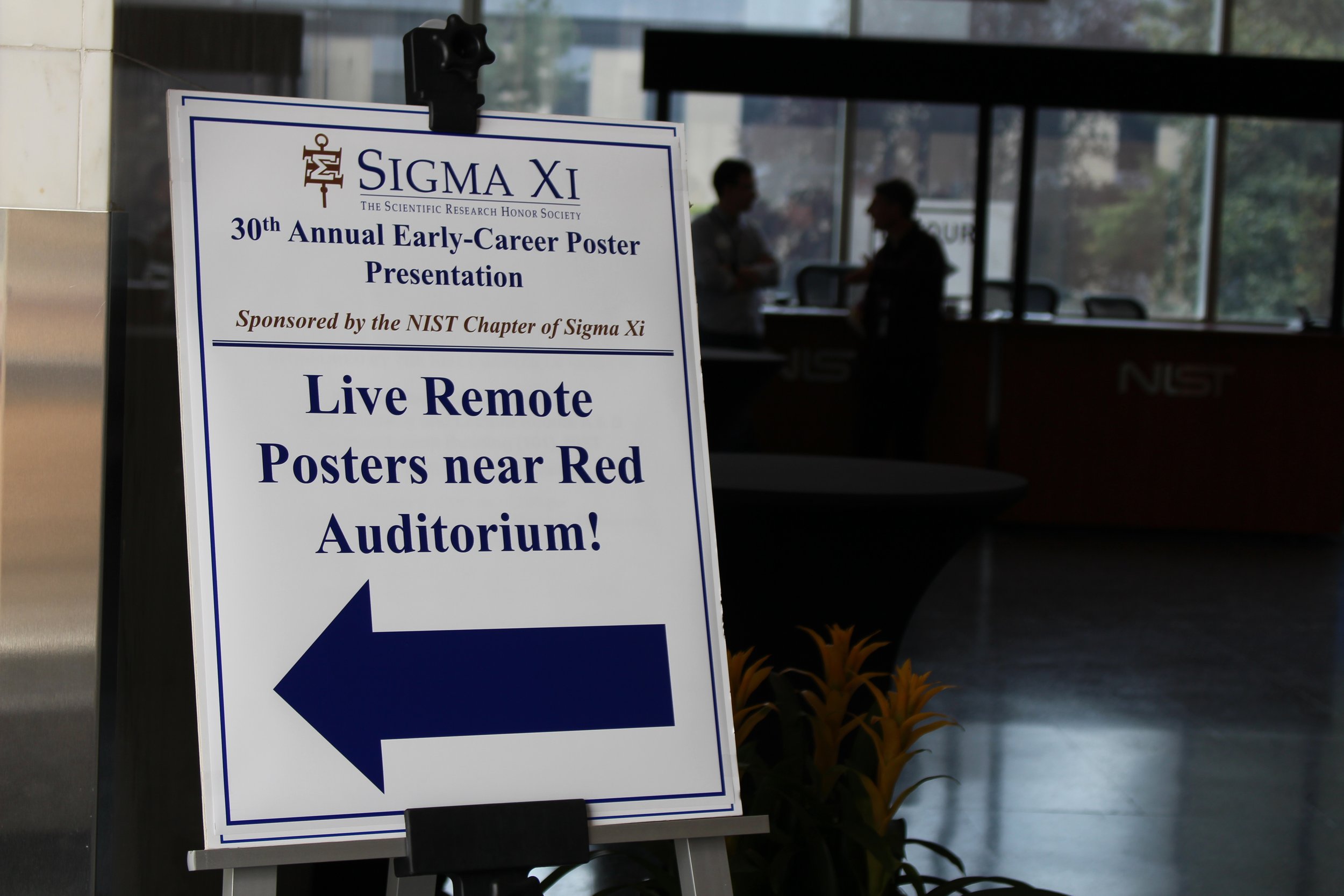






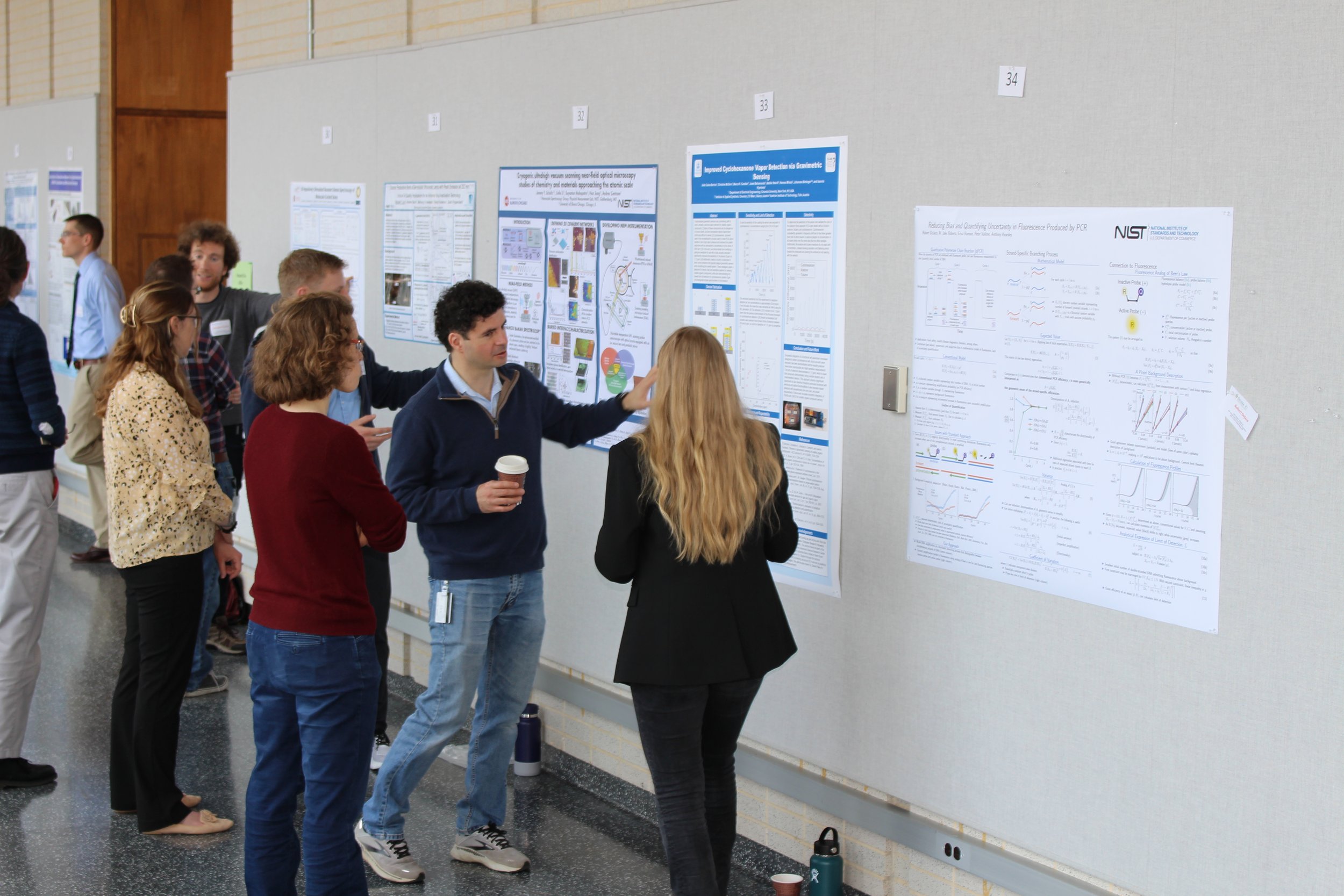






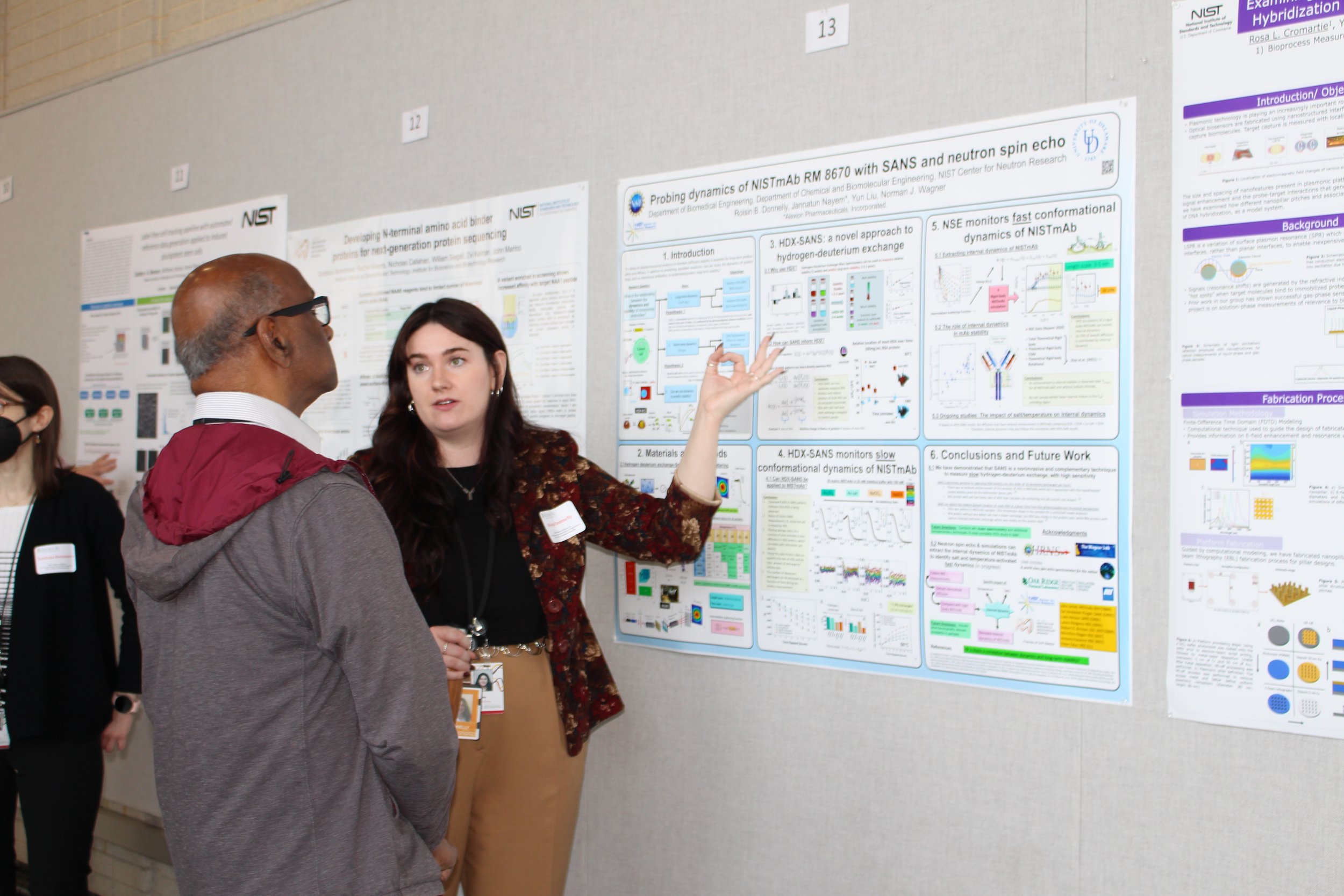



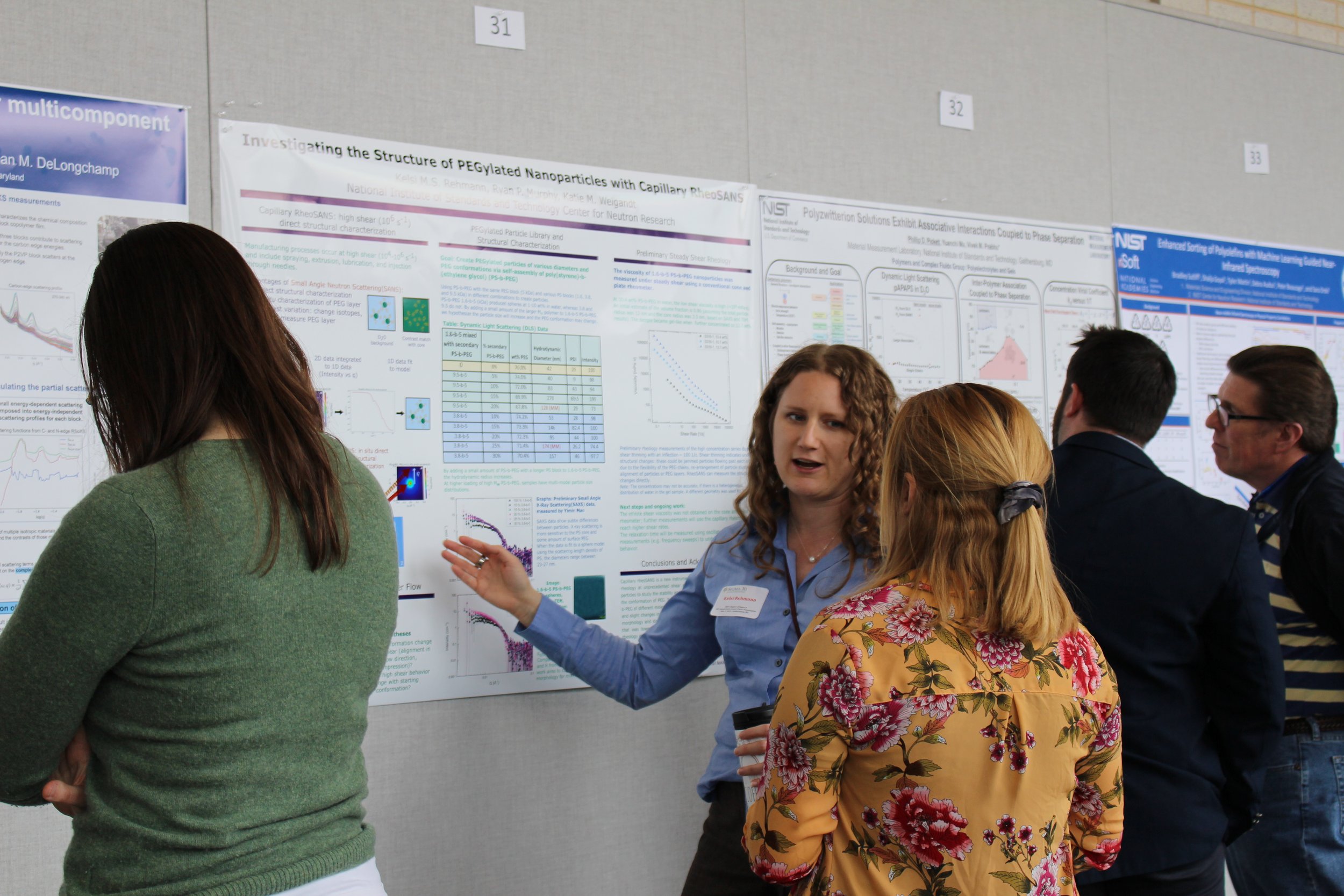
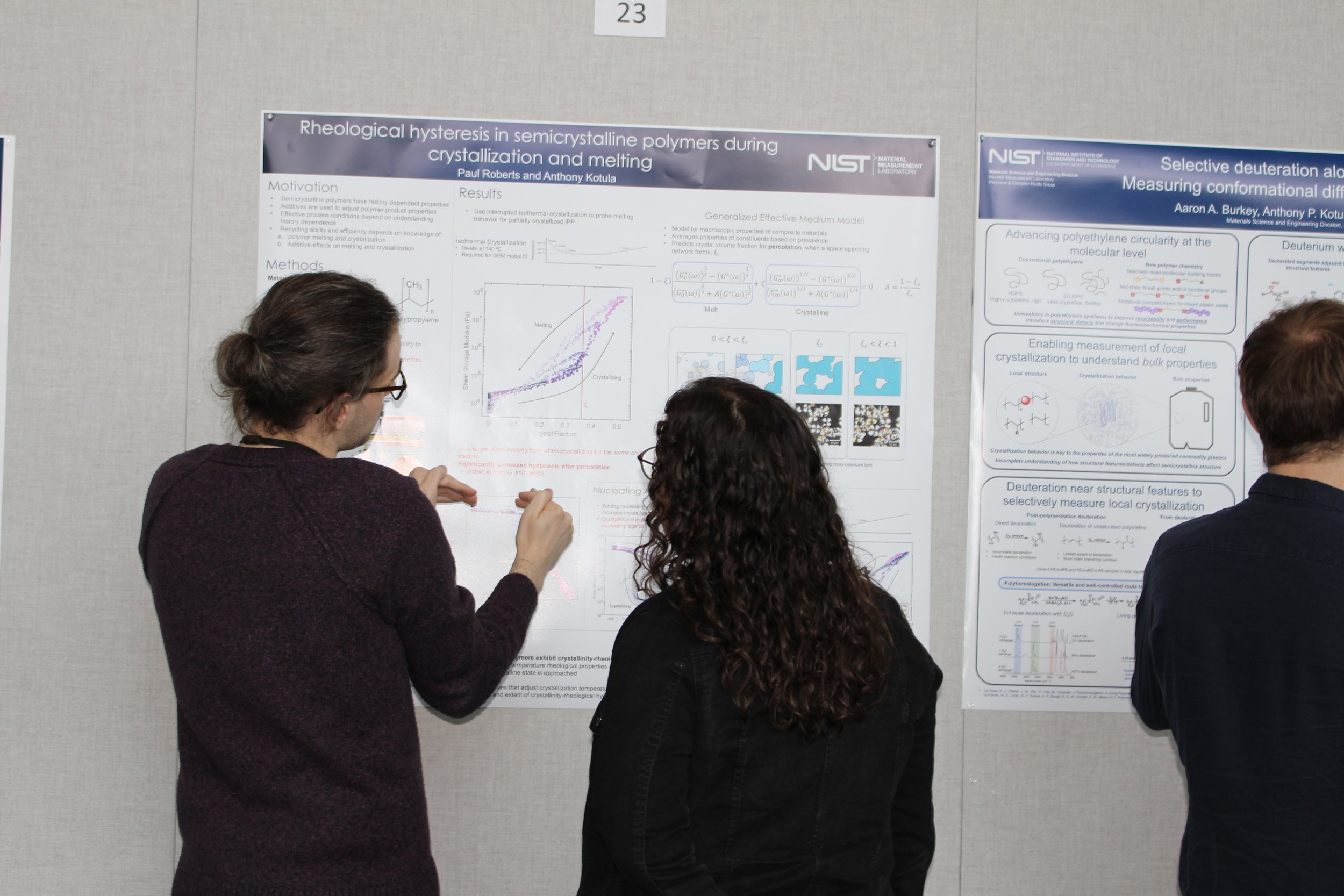












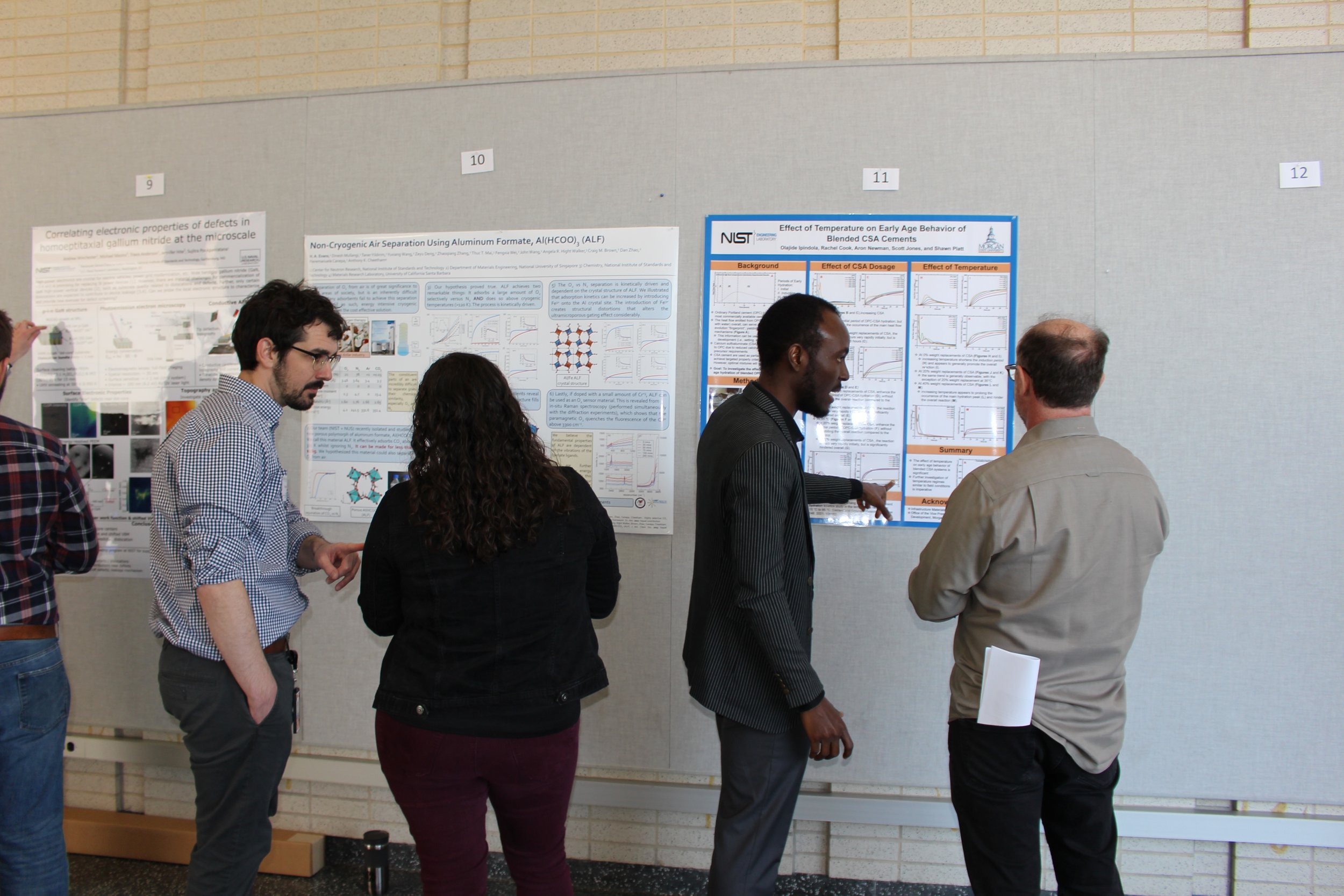





















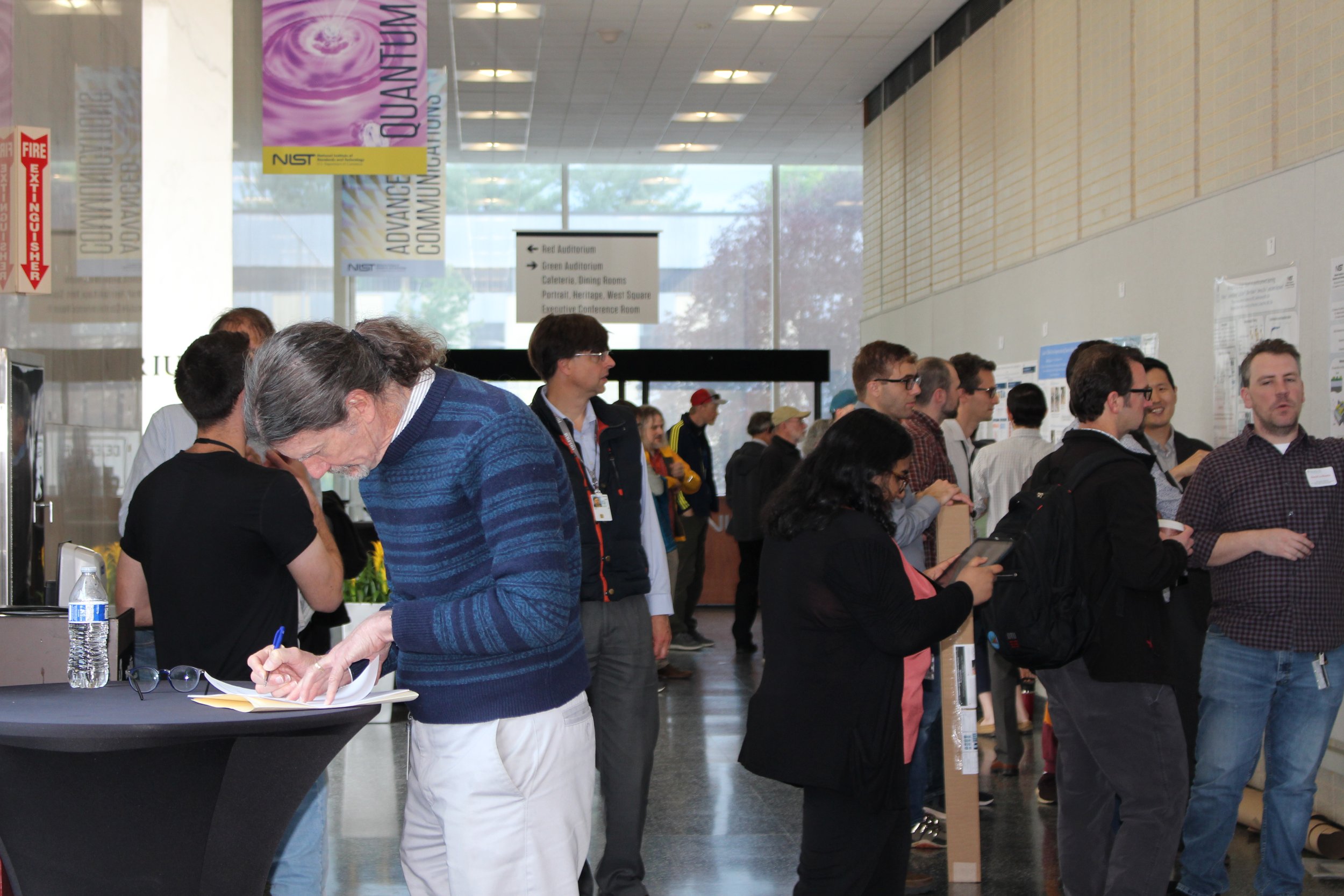











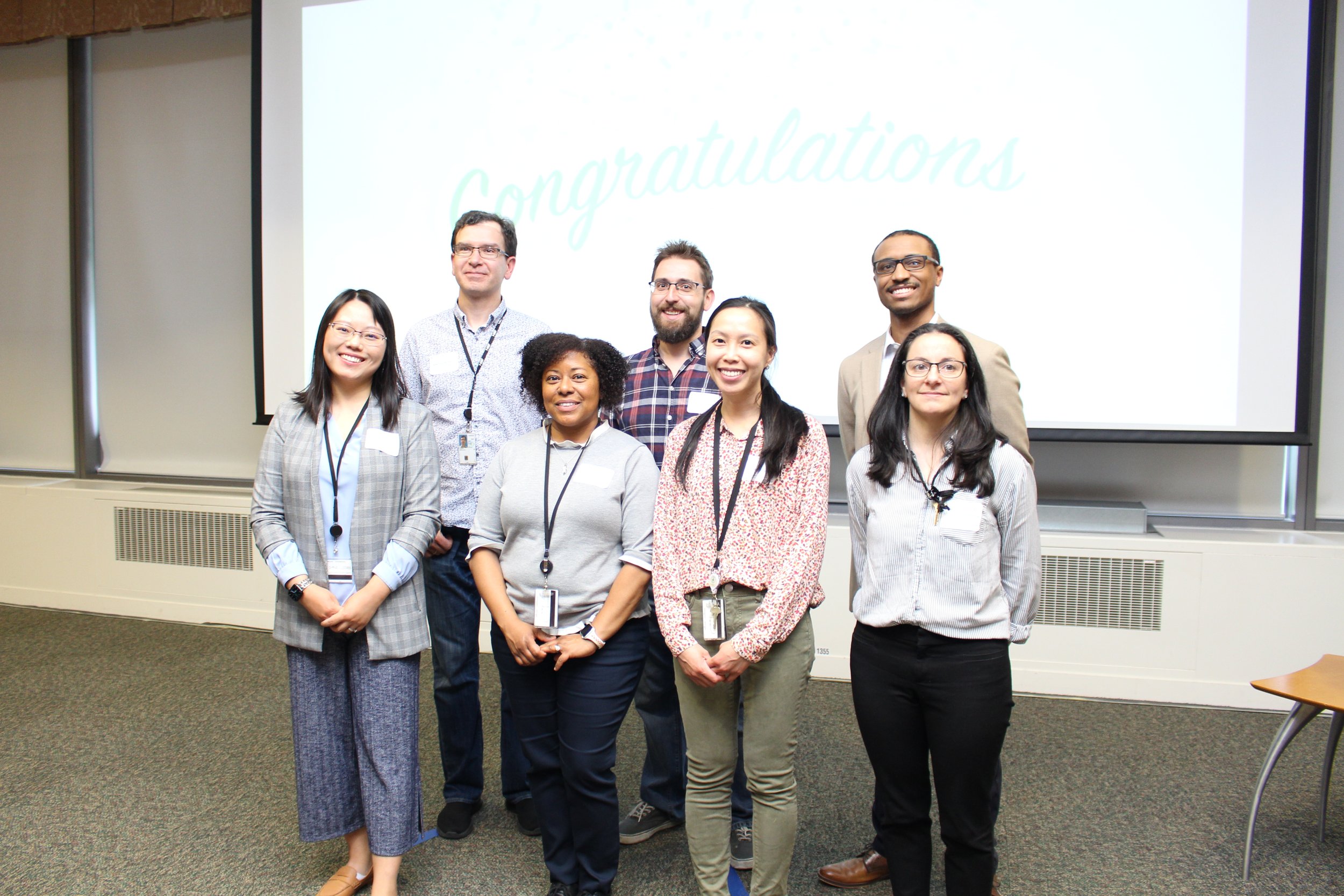

32nd ANNUAL NIST SIGMA XI Early-Career POSTER PRESENTATION
**Click here for the abstract book of the 32nd annual nist sigma xi ecpp**
PRESENTERS: See EVENT INFORMATION AND SUGGESTIONS HERE
ABSTRACT DUE DATE: FRIDAY, MARCH 14, 2025 (Now closed)
EVENT DATE: Wednesday, April 30, 2025
Gaithersburg
Location: Building 101, Hall of Flags
Session I: 10:00 AM - 12:30 PM EDT
Session II: 1:00 PM - 3:30 PM EDT
Awards ceremony: 4:30 pm EDT, 101/Heritage Room
Boulder
Location: Building 81, Room 1A116
Session I: NOON - 2:00 PM MDT
Awards ceremony: 2:30 PM MDT, 81/1A116
The NIST Chapter of Sigma Xi invites all early-career staff and associates to present a poster on their scientific or technical research to their NIST colleagues at the 32nd Annual NIST Sigma Xi Early-Career Poster Presentation (ECPP). The ECPP will take place during two sessions on Wednesday, April 30th, 2025 in the Hall of Flags of the Gaithersburg Campus’ administration building (Building 101) and one session in Building 81 Room 1A116 on the Boulder Campus. To participate, please register and submit an abstract (now closed). The deadline for abstract submission is Friday, March 14th, 2025. Those new to NIST may present research from their previous institution. All presenters and event attendees are also invited to an awards reception at the end of the day, where the most outstanding posters from each session (as determined by anonymous judges) will be announced following remarks by Acting NIST Director Craig Burkhardt. Awards eligibility is limited to staff and associates who have earned their terminal degree in the last five years and we ask that participation is kept to those seven years or less from their terminal degree. Presenter space is limited, so please submit your abstract early.
During registration, authors must choose the topical category that best classifies their poster:
· Biological Sciences (including Biology, Biochemistry, and Biotechnology)
· Chemical Sciences (including Chemistry and Chemical Engineering)
· Computer Sciences (including Artificial Intelligence, Machine Learning, and Software Programming)
· Cybersecurity & Wireless Communication Technologies
· Civil/Mechanical Engineering and Manufacturing
· Dissemination of the SI & Standards (including SI Metrology and Measurement Services)
· Electrical Engineering
· Material Science
· Mathematical Sciences (including Mathematics, Statistics, and Data Science)
· Physics
· Polymer Science
Benefits of Participation
NIST Sigma Xi’s annual poster event is one of the few NIST-wide research forums available to showcase your work. This represents an excellent opportunity to make connections in other parts of NIST and across NIST OUs to advance your research and forge new collaborations. In addition, this is a great resume-building opportunity and a unique way to showcase your results!
CLICK HERE FOR REGISTRATION AND ABSTRACT SUBMISSION SUbmission now closed
A registration fee of $25 for Sigma Xi members and $50 for non-Sigma Xi members will be paid by the operation unit (OU) of each registrant.
Please contact Organizing Committee Chair Christina Bergonzo or the NIST Sigma Xi Executive Board with any questions.
JUDGES: If you are interested in helping to judge posters, please contact Judges Chair Monique Johnson.
VOLUNTEERS: If you would like to support our early-career researchers through this event, consider joining the Sigma Xi Early-Career Poster Presentation Organizing Committee or volunteering to help with day-of setup. If interested, please contact the NIST Sigma Xi Executive Board.
32nd annual Early-Career poster presentation AWARD WINNERS
**Click here for the abstract book of the 32nd annual nist sigma xi ecpp**
Biological Sciences, Chemical Sciences, Computer Sciences, and Mathematical Sciences
MOST OUTSTANDING: Robert Gutierrez, “Transepithelial electric resistance (TEER) measurements for the development of an in vitro human gut model”
OUTSTANDING: Mahir Mohiuddin, “CHIR99021-induced epithelial-to-mesenchymal transition of induced pluripotent stem cells show similar physicochemical changes with and without B27 supplementation, but B27 enables cardiomyocyte differentiation”
OUTSTANDING: Joel Vasanth, “Interpreting generative AI: Explaining how poisoned large language models can encode Trojan behavior”
MATERIALS Science AND POlymer Science
MOST OUTSTANDING: Katarina Goodge, “Electrostatic characterization of tribocharging of fiber blends”
OUTSTANDING: Stephen Moxim, “Electron paramagnetic resonance observations of performance limiting defects in amorphous silicon/niobium films relevant to superconducting Josephson junctions”
OUTSTANDING: Kelsi Rehmann, “Shear-induced crystallization of soft nanoparticles measured with capillary rheoSANS”
PHYSICS
MOST OUTSTANDING: Dario D’Amato, “Nondestructive characterization of cold atomic clouds with machine learning”
OUTSTANDING: Cory Nunn, “Picosecond synchronization for quantum network sources and measurement”
OUTSTANDING: Marvin Schewe, “Measuring femtometer-scale vibrations at 40 GHz and beyond for next-generation mobile wireless communications”
CIVIL/Mechanical Engineering & Manufacturing, electrical engineering, and dissemination of the Si & Standards
MOST OUTSTANDING: Adam Pearce, “Utilizing alpha and mass spectrometry in the impurity assessment of a 239Pu standard reference material”
OUTSTANDING: Liam Connolly, “Microwave frequency comb interrogation of high-overtone bulk acoustic resonators for high-speed, multi-modal mass sensing”
OUTSTANDING: Max Low, “A novel flow standard for accurate process gas measurements”
NIST Boulder (All topical categories)
MOST OUTSTANDING: Avirup Roy, “X-ray detector development for carbon catalysis”
OUTSTANDING: Colby Evans, “Characterization of MoS2 Under DC Bias”
31st annual Early-Career poster presentation AWARD WINNERS
** CLICK HERE TO SEE THE ABSTRACT BOOK OF THE 31st ANNUAL SIGMA XI ECPP **
Biological Sciences, Chemical Sciences, and Polymer Science
MOST OUTSTANDING: Caitlyn Wolf, “Small-angle scattering and dark field imaging measurements for validation of a new neutron far-field interferometer”
OUTSTANDING: Charlotte Wentz, “Facilitating a circular economy of textiles”
OUTSTANDING: Kelsi Rehmann, “High shear, capillary rheoSANS of block copolymer micelles”
MATERIALS Science AND Dissemination of the SI and Standards
MOST OUTSTANDING: Jacob Garcia, “NUV and EUV pulsed atom probe tomography of semiconductor materials”
OUTSTANDING: Tehseen Adel, “Angle-resolved polarized Raman methodology for determining lattice plane orientations of 2D materials”
OUTSTANDING: Lakshmi Ravi Narayan, “Codesign of nanocalorimetry sensors using correlated FEA simulations and experiments”
PHYSICS
MOST OUTSTANDING: Robbie Elbertse, “Magnetic lifetime anomaly near a diabolic point of an atomically crafted spin chain”
OUTSTANDING: Charlezetta Wilson-Stokes, “Optical spectroscopy of graphullerene: 2D layers of covalently bonded fullerenes”
OUTSTANDING: Marvin Schewe, “Advancing high-frequency microwave acoustic vibration measurements with pulsed laser interferometry”
CIVIL/Mechanical Engineering & Manufacturing, Cybersecurity & Wireless Communication Technologies, Computer Sciences, and Mathematical Sciences
MOST OUTSTANDING: Melinda Kleczynski, “Topological data analysis of molecular dynamics simulations of the NIST monoclonal antibody”
OUTSTANDING: William “Drew” Borders, “How to train robust solutions for neuromorphic hardware with strong defects”
30th annual Early-Career poster presentation AWARD WINNERS
biological sciences, chemistry, and mathematical sciences
MOST OUTSTANDING: Sierra Miller, “Metadata, Data Management, and Bioinformatic Analyses to Advance Confidence in Genome Editing Technologies”
OUTSTANDING: Julia Greenfield, “Characterization of Freeze-induced Transient High-molecular-weight (HMW) Species in BiTE® Solution”
OUTSTANDING: Michael Link, “Ozone Generation from a Germicidal Ultraviolet Lamp with Peak Emission at 222 nm”
MAterials and Polymers
MOST OUTSTANDING: Devon Jakob, “Visible to Mid-IR Spectromicroscopy with Top-down Illumination and Nanoscale (≈10 nm) Resolution”
OUTSTANDING: Robert Ivancic, “Predicting the Toughness of Compatibilized Blends”
OUTSTANDING: Pavel Shapturenka, “Assembly and Characterization of Length-sorted, Aligned Boron Nitride/Carbon Nanotube Thin Films via Slow Dead-end Filtration ”
Physics, Engineering & manufacturing, and computer sciences
MOST OUTSTANDING: Corey Frank, “Understanding Unconventional Superconductivity in Very High Magnetic Fields”
OUTSTANDING: Yulia Maximenko, “A Quantum Ruler for Orbital Magnetism in Moiré Quantum Matter”
OUTSTANDING: Sarah Robinson, “Development of a 5,000+ Channel Microfluidic Dynamic Source Grating Device for Neutron Interferometry”
29th annual Early-Career poster presentation AWARD WINNERS
PHYSICS
Sylvia Lewin, “Anisotropy of the Superconducting Upper Critical Field in UTe2”
Sean Blakley, “Hardware Algorithms for Fast, Efficient Measurements with Bayesian Experimental Design”
Biological Sciences and Chemistry
Katherine Shaw, “A Novel Methodology for the Removal of Microplastics from Deep Sea Sediments”
Kirsten Parratt, “Cell Spike-ins Add Assurance to Flow Cytometry Measurements of Complex Microbial Communities”
Polymers and Materials
David Goggin, “Degradation of CVD-Grown MoS2 Particles Subjected to DC Electrical Stress”
Kristof Toth, “Contrast-Variation Resonant Soft X-ray Scattering for the Extraction of Partial Scattering Functions in Multicomponent Soft Matter Systems”
Engineering & Manufacturing and Mathematical & Computer Sciences
Rayanne Luke, “Improving SARS-CoV-2 Diagnostic Testing Accuracy by Moving to Higher Dimensional Probability Models”
Vinh Nguyen, “Measurement Techniques for Human Cyber-Physical Systems in Industry 4.0”
28th annual postdoctoral poster presentation AWARD WINNERS
Biology, Biotechnology, and Chemistry
Zeus De los Santos, “Stereoselective photoluminescent properties of DNA-SWCNTs with chiral amino acids: a primer for molecular perceptron”
Katherine Peter, “Towards quantitative applications of high resolution mass spectrometry: data reduction, matrix effects, and non-target signature fidelity”
Artificial Intelligence, Machine Learning, Engineering, Nanotechnology, and Math
Matthew Daniels, “Quasisystolic arrays for pipelined and resource-efficient neural network training”
Siyuan Zhang, “Chemically and electrically tunable emission from charged and neutral excitons in monolayer WS2”
Materials and Polymers
Lilian Johnson, “Dynamically consistent coarse-grained models of chemically specific polymer melts via friction parameterization”
Georges Pavlidis, “Long-lived, long-travelling hyperbolic phonon polaritons in isotopically enriched (10B) hexagonal boron nitride”
physics
Rebecca Dally, “Neutron diffraction studies on the itinerant kagome helimagnet YMn6Sn6”
Benjamin Heacock, “Pendellösung interferometry probes the neutron charge radius, lattice dynamics, and fifth forces”
27th annual postdoctoral poster presentation
Cancelled due to COVID-19.
26th annual Postdoctoral Poster Presentation AWARD WINNERS
Biology, Biotechnology, and Chemistry
Ilabahen Patel "Synthesis and characterization of fluorescent cellulose nanofibrils for toxicological risk assessment"
Christina Bergonzo, "Maximizing accuracy of RNA structure in refinement against residual dipolar couplings"
Artificial Intelligence, Machine Learning, and Materials
Adam Biacchi, "Raman crystallography as a probe of phonon-mediated anisotropic carrier mobility in single crystal organic semiconductors"
Siyuan Zhang, "Contact engineering for monolayer transition-metal dichalcogenide by molecular doping"
Engineering and Physics
Amber McCreary, "Spin-phonon coupling, spin waves, and other phenomena in layered magnetic materials via Raman spectroscopy"
Ryan Need, "Exchange bias and closure domains in a ferromagnetic multilayer with orthogonal anisotropies"
Nanotechnology and Polymers
Ryan Murphy, "Capillary Rheo-SANS: Measuring the nanostructure and rheology of complex fluids at high shear rates"
William McGehee, "Direct-write lithiation of silicon using a focused ion beam of Li+"
25th annual Postdoctoral Poster Presentation AWARD WINNERS
engineering and polymers
Joel Sarapas, "A route to idealized networks using bottlebrush polymers"
Tyler Martin, "pyPRISM: A computational tool for liquid-state theory calculations of macromolecular materials"
Information technology, mathematics, and materials
Trevor Braun, "The role of additive surface adsorption during electrodeposition: How fundamental measurements linked to theoretical models enhance material design"
Adam Biacchi, "Measuring electrical transport in individual anisotropic 2D colloidal nanocrystals or How i learned to stop worrying and employ time-resolved terahertz spectroscopy"
biology, biotechnology, and chemistry
Edward Kwee, "Large field of view quantitative phase imaging of induced pluripotent stem cells and optical pathlength reference materials"
Kevin Roy, "Multiplexed accurate genome editing with trackable, genomic barcodes"
physics
Daniel Walkup, "A quantum Berry phase switch in circular graphene resonators"
Roberto De Alba, "Absolute deflection measurements in a MEMS/NEMS Fabry-Perot interferometry system"
24th annual Postdoctoral Poster Presentation AWARD WINNERS
Electronic & Magnetic Materials and Engineering
Brian Roxworthy, "Electromechanical resonance tuning and phonon lasing of individual optical meta‑molecules"
Yiliang Bao, "An optomechanical accelerometer with a high‑finesse hemispherical optical cavity"
Biology, Biotechnology, and Chemistry
Connie Remoroza, "Fingerprinting prebiotic oligosaccharides in NIST human milk reference material (SRM 1953) by HILIC-ESI mass spectrometry"
Erica Stein, "Considerations for digital droplet PCR to quantitatively measure miRNA using a two-stage method"
Computer Modeling & Simulation and Physics
Qing Li, "Octave Spanning microresonator frequency combs for metrology"
MD Hassan, "The precision measurement of the electron-antineutrino correlation in neutron beta decay"
Nathan Mahynski, "Self-assembly of multi-flavored two-dimensional colloidal crystals"
Energy, Water, & Environment and Polymers
Mirjana Dimitrievska, "Neutron Scattering Studies of Hygrogenous Materials for next generation energy storage"
Kenneth Mineart, "Versatile cholesterol functionalized block copolymers in aqueous dispersions"
23rd annual Postdoctoral Poster Presentation AWARD WINNERS
Physics and Engineering (P, E)
Jason Liu, “Nitrogen-vacancy magnetometry on patterned permalloy nanostructures”
Jacob LaManna, “Simultaneous multimodal neutron and x-ray imaging for multiphase quantifications in engineering and material science”
Materials (M)
Nicholas Bedford, “Elucidation of sequence-dependent structure/function relationships for monometallic and bimetallic nanoparticles: toward the establishment of bio-inspired rational design rules”
Nathan Mahynski, “Entropic control over nanoscale colloidal crystals”
Chemistry, and Polymers (C, Y)
John Royer, “A rheological signature of frictional interactions in shear thickening suspension”
Adam J. Biacchi, “Novel solution chemistry routes to 2D tin chalcogenide nanoelectronic device components”
Biology and Biotechnology (B, BT)
Elizabeth Kelley, “Towards understanding the role of lipid diversity in tuning biomembrane dynamics”
James Hands, “Rapid brain cancer diagnostics: Stratified blood serum analysis via ATR-FTIR spectroscopy”
22nd annual Postdoctoral Poster Presentation Award Winners
Physics (P)
Karen E. Grutter, “Stress-Tuned Si3N4 Slot-Mode Optomechanical Crystals”
Ryan Beams, “Sub-Diffraction Microscopy of Two Dimensional Materials”
Materials (M)
Bharath Natarajan, “3D Electron Tomography for Quantitative Analysis of Aligned Carbon Nanotube Filled Polymers”
Alexander Grutter, “Probing Domain Structure in High-Density Segmented Nanowire Arrays through Polarization Analyzed SANS”
Chemistry, Engineering, and Math (CEM)
Bryan A. Bryce, “Mechanical silicon vapor-liquid-solid nanowire sensors”
Krishna C. Balram, “GaAs piezo-nanobeam optomechanical cavities”
Biology, Biotechnology, and Polymers (BBP)
P. Douglas Godfrin, “Cluster mediated dynamics and viscosity in concentration protein formulations”
Muzhou “Mitchell” Wang, “Dynamics of entangled-rod-coil block copolymers”